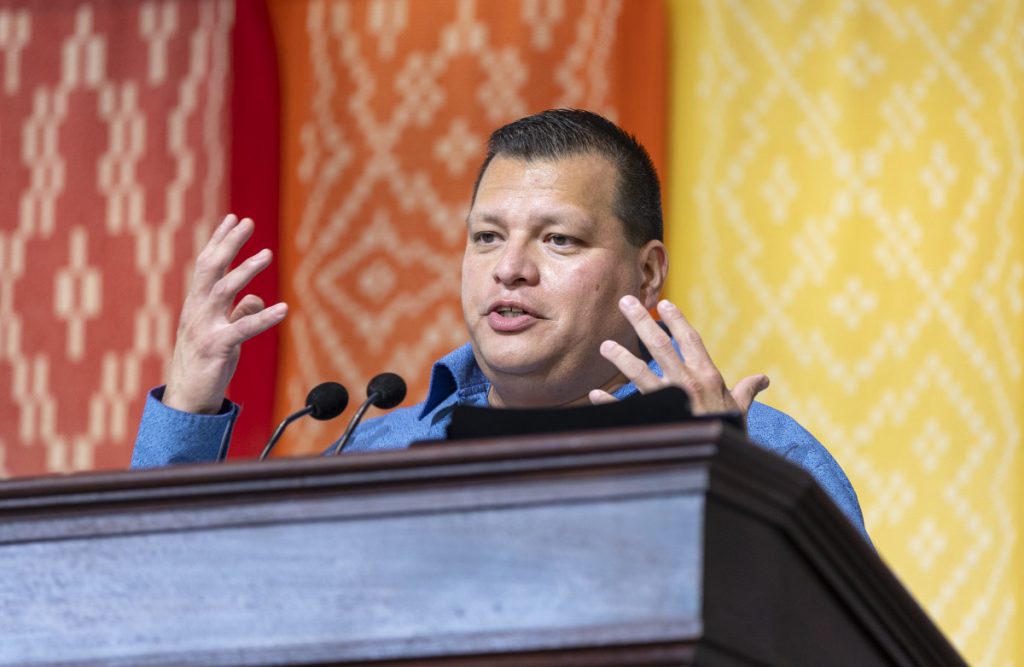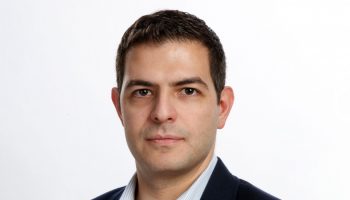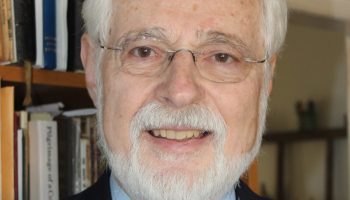MAX ZAMBRANO – STAFF WRITER

He doesn’t claim to be a lawyer, legal expert or scholar in any way, nor is he looking to convert anyone. What Michael Martin wants people to do, however, is look deeper into their own beliefs or faith, all the way back to creation stories.
Martin, the executive director for Native American Community Services of Erie and Niagara Counties, wants people to consider this topic because he wants them to consider the foundation of America’s ethical principles.
“The national narrative that we extoll is that America was founded on ethical principles born out of religious freedom and fervor, with the moral imperative of justice for all,” Martin said. “But how accurate is this narrative?”
This quote hung above the Amphitheater stage, shown for all to see on its several huge screens. The word “ethical” was clearly underlined.
“As you get through this lecture and hear about the Doctrine of Discovery, maybe that might be something to reconsider,” he said.
Martin presented this argument at 1 p.m. in the Amp on Tuesday, July 20 in his lecture titled “The Doctrine of Discovery: An Unjust Imperative, Born Out of Religious Justification — A Presentation of the Tragic and Lasting Consequences of Supremacy,” part of Week Four’s Interfaith Lecture Series themed “The Evolving Religious Narrative of America.”
“I hear this idea of religious freedom a lot,” Martin said. “Often times it’s ‘Don’t impede on my religious freedom, but if I express my religious freedom, I have to suppress your religious freedom.’ ”
Martin acknowledged there is a multifaith evolution occurring, but he said this wasn’t always necessary.
“If you think about that, it’s true, but if we were accepting that there were others not a part of our faith from day one, we wouldn’t need an evolution,” he said. “We could’ve accepted there were others, separate but equal.”
Historically, in a religious context, some have seen themselves as supreme over others, Martin said. This mindset has caused consequences spanning back hundreds of years to the present day, he said.
Martin started in the 15th century when people began using religious and legal grounds for justifying the seizure of foreign lands if no Christians lived there.
In 1452, Pope Nicholas V commanded King Alfonso V of Portugal to “invade, capture, vanquish and subdue all saracens and pagans” in Africa on the basis of religion, Martin said.
Forty years later, Christopher Columbus sailed the ocean blue in search of a shortcut to India. Although he actually landed in North America, he believed at first he reached India and called the people he encountered “Indians.”
“This is why we’re called Indians,” Martin said. “Native groups say, ‘We’re not even Indians.’ That was our first misclassification that we carry on to this day.”
Martin then noted the pushback against celebrating Columbus Day because, although Columbus introduced the Americas to those back in Europe, he also introduced slavery and devastation across Indigenous Americans.
He joked that on Columbus Day, people should celebrate by going to any store, declare that they discovered an item and take it home for free.
“It’s basically the same premise,” he said. “It takes away Native Indigenous rights to own the land. Even in the U.S., the premise is that the land is no longer ours and is forever ceded — just by the idea they discovered us.”
Another historical example with present-day consequences was the 1494 Treaty of Tordesillas. At this time, the New World was divided between Spain and Portugal, Martin said. This new treaty gave Portugal some extra land in South America, in what is now Brazil. Today, Brazil speaks Portuguese, while the rest of the continent largely speaks Spanish.
In 1496, King Henry VII of England began using religious justification for seizing land, Martin said.
In 1514, “The Requerimiento,” which translates to “Requirement,” added an extra step for explorers, having them read a document to Indigenous Americans of Spain’s legal and moral right to rule over the inhabitants. If they did not agree, they would be enslaved, Martin said.
“If I came to you in my native language and smiled while doing it, your good hearts might open your doors and say, ‘Oh look at this poor person traveling who must be lost. He must need a place to stay. Let’s try to give him food and understand him,’ ” Martin said. “Then, I continue to stay, and after a while you wonder when I’ll leave.”
Continuing the hypothetical, Martin said he’d become more testy and start threatening and killing his hosts’ family. If he were to be attacked back, he would call his hosts savages.
“It sounds crazy, right? It sounds odd,” he said. “It’s the same basic principles of the Doctrine of Discovery.”
Martin listed 10 elements of the Doctrine of Discovery: The first defined Christianity as the basic justification. The second element was civilization, and who gets to determine what and who was civilized.
“This was where we got into these elements of supremacy,” he said, “to say a way of life for somebody else is less than yours.”
The third and fourth elements were first discovery and actual occupancy and possession. First discovery is based on Columbus, which led to more sanctioned trips from more countries to occupy and possess the land, without regard to Indigenous people who already occupied it, Martin said.
Similarly, the fifth element of preemption allowed European countries to claim rights to the land, which led to the sixth element: Indigenous people lost any right or title to the land, he said.
The seventh element gave Indigenous people no right to trade, Martin said.
In the eighth element, contiguity, one could go to the mouth of a river and claim they own the entire river, he said.
“Imagine landing in New Orleans and saying, ‘Ah, this (is the) Mississippi River. I’m going to lay claim to its beginning without any occupancy or exploration,’ ” Martin said.
The ninth element said if no Christians occupied the land, it could be considered vacant or empty, and the 10th and final element defined conquest, which added a religious justified military framework.

Martin, part of the Haudenosaunee people, said his ancestors believed everyone had the same original instructions based on their creation story.
In his condensed version of the story, he described a pregnant woman falling from the sky world to the earth, which was entirely made of water. Birds saved her, and a giant turtle then allowed her a place to rest. All the sea animals swam to the bottom of the ocean to gather dirt to make the turtle’s back softer, but only one survived.
After dumping the dirt on the turtle, the woman began walking counterclockwise, and the land began to expand.
She gave birth to a daughter, who eventually gave birth to two twin sons, with one born naturally and the other coming out of her armpit area, killing her. Plants began sprouting from her grave, so she is called Mother Earth, he said.
One of these sons creates four humans, Martin said, who are given the same instructions on how to live and treat others and the natural world. These four were then sent off in four different directions. A prophecy claims they would come back to share what they learned for the sake of humanity.
Martin noted there are 13 plates in the middle of a turtle’s back and 28 on the outside. The 28 are used for the lunar calendar, and he said of Earth’s tectonic plates, 13 are the homes of human beings. He said we all have the same original instructions from those four humans.
Based on this story, his ancestors accepted all foreigners as humans with the same basic needs.
“Our ancestors didn’t see it as a father-and-son relationship, but brothers and sisters,” he said.
His organization, the Native American Community Services of Erie and Niagara Counties, is focused on trauma-informed care, which he said is asking people not what’s wrong with them, but rather what happened to them.
He said everyone experiences trauma, which can be current, like a car accident or post-traumatic stress disorder from war, or it can be intergenerational, stemming from historical trauma.
Sympathetic to the trauma of Native people, he wondered what trauma those in early Europe might have faced, which would have influenced their actions and behaviors in the Doctrine of Discovery.
In northern Europe, he said, where harsh winters took over the land, people were forced to hunt and harvest well to survive the winter. According to a documentary he watched, Martin said, those who didn’t do well would attack their nearest neighbor to survive.
“This starts an age of living in excess — because you need to have enough for yourself and if you get attacked,” he said.
He finds this idea of excess and supremacy harmful to both humans and wild animals.
Martin then shifted his focus to land claims, noting that consequences of colonization are not just from 15th-century documents.
He cited the 1823 Johnson v. M’Intosh U.S. Supreme Court case, where one person purchased land through Native people and another purchased the same land through the federal government. Chief Justice John Marshall cited the Doctrine of Discovery, saying that even though Native Americans occupied the land, it was considered unoccupied because they were not Christians, Martin said.
This decision, Martin said, has been cited in courts around the world ever since. In another case, City of Sherrill v. Oneida Indian Nation New York, in 2005, the Doctrine of Discovery is referenced in the first footnote.
Justice Ruth Bader Ginsburg wrote that majority opinion.
“These courts weren’t made for us,” Martin said.
Another example Martin gave was the largest mass execution in U.S. history, in 1862, when President Abraham Lincoln ordered the execution of 38 Dakota tribe members accused of rebellion. This was in contrast to Lincoln’s treatment of white secessionists in the wake of the Civil War.
Martin hopes people come back to creation and original instructions.
“Are we all brothers and sisters, or is that just something we say?” he said.
There have been instances of repudiation, he said, such as the United Nations’ 2007 Declaration on the Rights of Indigenous Peoples. A few years later, 13 Catholic groups were in solidarity with Indigenous peoples’ request of asking Pope Francis to rescind 15th-century declarations, Martin said.
“We need to focus on our common humanity, and we need to live in balance and harmony to achieve peace and wellbeing,” he said. “When I talk about peace, it’s balance and harmony within ourselves, with each other and with all of the natural world. Let’s always remember, and no longer forget, our common humanity. And please also don’t forget: We all smile in the same language.”




